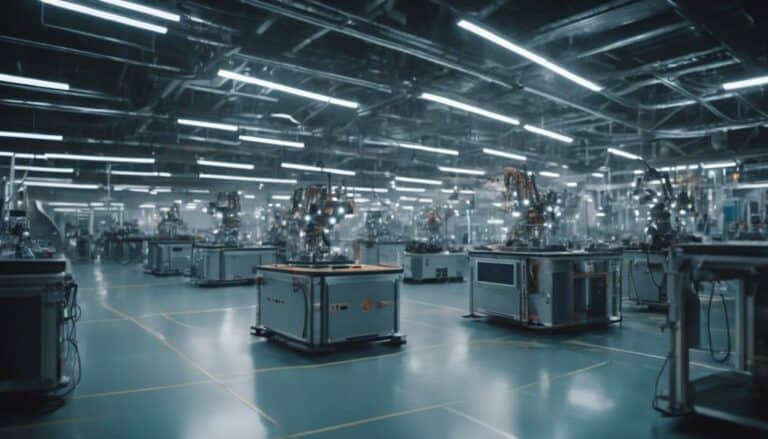When it comes to modern machines, the drive towards energy efficiency is paramount. Imagine the impact of upgrading equipment to not only optimize performance but also reduce energy consumption drastically. The integration of cutting-edge technologies in motor systems and control optimization is revolutionizing industrial practices. Efficiency gains are not just about numbers; they are a direct contribution towards sustainability goals. So, how exactly are these upgrades reshaping the landscape of industrial machinery and what benefits do they offer?
Key Takeaways
- Upgrade to energy-efficient motors like Permanent Magnet Synchronous Motors (PMSM) for high power density.
- Implement High Response Control Optimization for fine-tuning motor loops and maximizing energy efficiency.
- Integrate advanced electrical energy reduction techniques for significant energy savings.
- Modernize industrial machinery with variable frequency drives and high-response control systems.
- Focus on sustainable equipment upgrades with renewable energy sources and real-time monitoring for efficiency.
Energy-Efficient Motor Systems
Upgrade your industrial equipment with energy-efficient motor systems to greatly reduce environmental impact and operating costs. Energy efficiency is paramount in today's industrial landscape, and the choice of motors plays a pivotal role in achieving this goal.
Permanent Magnet Synchronous Motors (PMSM) offer high power density and rapid acceleration, making them ideal for applications requiring quick response times. Dual Winding Motors provide a broad constant power band, allowing for swift acceleration and overall enhanced energy efficiency.
Control mechanisms such as High Response Vector (HRV) guarantee that commands are adjusted in real-time based on load and RPM, maximizing productivity while maintaining accuracy. Additionally, incorporating power source regeneration in drive systems helps to minimize waste heat and inefficiencies, leading to significant energy savings over time.
High Response Control Optimization
To further enhance energy efficiency and operational performance in your industrial equipment, explore the world of High Response Control Optimization. This method involves fine-tuning motor loops at high rates based on load and RPM to drive increased productivity.
High Response Vector (HRV) control optimizes these motor loops, ensuring that acceleration and speed are improved through mechanical changes in motor design. By utilizing permanent magnet synchronous motors, you can benefit from high power density and rapid acceleration capabilities.
Precision software and advanced switching devices are essential for the efficient operation of pulse width modulated drives in this scenario. Optimizing acceleration and maximum speeds not only enhances performance but also reduces cycle times, leading to energy savings without compromising accuracy.
Embracing High Response Control Optimization can greatly boost the efficiency and effectiveness of your industrial equipment, making it an essential aspect of modernizing machinery for improved productivity.
Advanced Electrical Energy Reduction
Enhance industrial equipment efficiency through the implementation of advanced electrical energy reduction techniques. To achieve ideal energy efficiency, consider integrating permanent magnet synchronous motors into your systems. These motors offer high power density and acceleration capabilities, contributing to significant energy consumption savings.
Implementing High Response Vector (HRV) control in motor systems is essential as it adjusts commands based on load and RPM, enhancing productivity while reducing energy usage.
For further energy reduction, utilize pulse width modulated drives with advanced switching devices. This setup improves acceleration and speed control in electrical systems, thereby increasing system efficiency.
Matching drive amplifiers and software features to your electric motors can also play a key role in reducing energy consumption in industrial applications. By focusing on advanced electrical energy reduction strategies, you can optimize cycle times, improve process efficiency, and ultimately decrease both environmental impact and operating costs.
Upgraded Industrial Machinery Examples
Modern industrial machinery examples showcase energy-efficient motors equipped with variable frequency drives for optimized performance. These motors adjust speed and torque to match the actual requirements of the equipment, reducing energy consumption during operation.
Modernized CNC machines feature high-response control systems that not only enhance precision but also contribute to energy efficiency in production processes.
Upgraded industrial ovens and dryers with advanced insulation help retain heat effectively, reducing heat loss and overall energy consumption.
Forklifts and cranes equipped with energy-saving features improve efficiency in material handling operations by utilizing energy more effectively.
Additionally, upgraded compressors and air systems with efficient controls play a significant role in minimizing energy waste, leading to lower operational costs for businesses.
These industrial machinery upgrades focus on improved efficiency and sustainability, aligning with the goal of optimizing energy usage in industrial settings.
Sustainable Equipment Upgrades
When considering sustainable equipment upgrades for manufacturing processes, focusing on energy-efficient components can lead to significant improvements in energy efficiency and cost savings. Incorporating renewable energy sources, smart controls, sensors, and other advanced technologies in equipment upgrades can optimize energy use. This aligns with green production practices and environmental stewardship goals. By reducing energy consumption through sustainable equipment upgrades, companies can not only save on operational costs but also contribute to a greener future.
| Energy Efficiency Components | Benefits | Implementation |
|---|---|---|
| Renewable Energy Sources | Reduced energy costs | Solar panels, wind turbines |
| Smart Controls | Efficient energy usage | Automated systems |
| Sensors | Real-time monitoring | Energy-efficient equipment |
These upgrades not only enhance operational efficiency but also demonstrate a commitment to environmental sustainability. By investing in sustainable equipment upgrades, companies can achieve both economic savings and contribute positively to the environment.
Conclusion
You've now seen how modern machines are being upgraded with energy-efficient motor systems, advanced control optimization techniques, and sustainable equipment upgrades.
These advancements not only improve performance but also contribute to reducing energy consumption and waste heat generation.
By incorporating these technologies, industrial equipment can operate more efficiently and effectively, aligning with sustainability efforts and making a positive impact on the environment.

